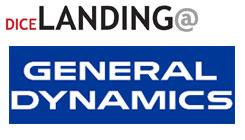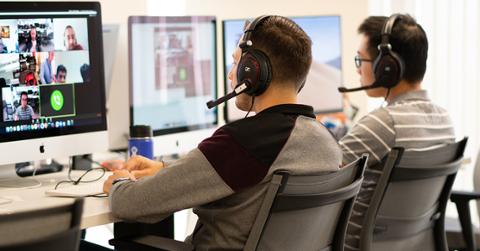
 Nicole Sharp is a wind tunnel jockey. “What’s that?” you ask. The short answer involves crawling around in wind tunnels big enough for a human to get around in, but not hot or windy enough to bake said human and blow them away. The longer answer is a whole lot more interesting. Sharp is a 27-year-old aerospace engineer and Texas A&M Ph.D. student and Amelia Earhart Fellow in fluids research. She spent her childhood in Arkansas and later lived in seven other states and Germany. She confesses to being a wanderer by nature, and like her fiancé, last month’s Featured Geek, Joseph Shoer, she’s been a curious scientist for nearly as long as she can remember. She's also in love with fluid dynamics, enough so that her highly engaging blog, Fuck Yeah Fluid Dynamics, has averaged over 11,000 unique visitors a month for the last year and is growing exponentially. It’s also a fascinating, entertaining read for the uninitiated and knowledgeable alike. Why did you choose to study Aerospace Engineering?
Nicole Sharp is a wind tunnel jockey. “What’s that?” you ask. The short answer involves crawling around in wind tunnels big enough for a human to get around in, but not hot or windy enough to bake said human and blow them away. The longer answer is a whole lot more interesting. Sharp is a 27-year-old aerospace engineer and Texas A&M Ph.D. student and Amelia Earhart Fellow in fluids research. She spent her childhood in Arkansas and later lived in seven other states and Germany. She confesses to being a wanderer by nature, and like her fiancé, last month’s Featured Geek, Joseph Shoer, she’s been a curious scientist for nearly as long as she can remember. She's also in love with fluid dynamics, enough so that her highly engaging blog, Fuck Yeah Fluid Dynamics, has averaged over 11,000 unique visitors a month for the last year and is growing exponentially. It’s also a fascinating, entertaining read for the uninitiated and knowledgeable alike. Why did you choose to study Aerospace Engineering? 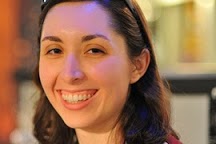 I’ve loved science as a way to explore the world for as long as I can remember. My mother was a science teacher, so I learned about Archimedes during bath time, explored botany on family hikes and learned chemistry while cooking. I had flings with archaeology and paleontology during early elementary school, but a love of astronomy and a classroom encounter with an artist’s depiction of the International Space Station — which at the time hadn't been launched — drew me into space. I remember looking at the ISS picture and turning to the kid next to me to say, “I’m going to live there one day.” From there I was hooked. The desire to build and touch as well as observe led me to aerospace engineering. It wasn’t until my junior year of college that I met aerodynamics and fluid mechanics. It was probably the first time in my engineering courses that a professor said we were done with a topic when I was still hungry for more. What exactly does a wind tunnel jockey do? As master’s students, a lab mate and I dubbed ourselves "wind tunnel jockeys" because our days in the lab had us constantly crawling around, into and over the wind tunnels. I was working with low-speed wind tunnels with velocities around 10 m/s (comparable to a stiff breeze) and test sections that were about 1 m^2, so it was easy to crawl inside to adjust our probes or apparatus during tests. These days I work on the other end of the spectrum, with a wind tunnel that runs at Mach 6 — that’s six times the speed of sound or about 860 m/s — in my tests. It’s much too small to get inside, and no one would want to be in there when it’s on. We heat it to the temperature of a baking oven and draw it almost down to a vacuum before we release the compressed air that starts hypersonic flow. While that’s on, about 1.5 kg of air go through the tunnel per second, and we can run that way for about 40 seconds. Your office is in the High Speed Wind Tunnel Facility at Texas A&M. I’m having visions of thematic desk decorations, or would like to think that having space near wind tunnels would inspire an unusual work environment. Am I warm or wildly off base? I wish I could say my lab mates and I have an awesome office set-up, but the truth is that our desks don’t look much different from any other grad student's. The big difference is in the adjacent rooms, which have a cadre of high-powered lasers and a handful of super- and hypersonic wind tunnels. They’re pretty loud when they’re operating, so every few hours there’s a warning horn followed by a building-shaking roar while one of the tunnels runs. We’re also off the main campus and right by the general aviation side of an airport that gets a lot of military training traffic. It’s not unusual to see F-16s, Apache helicopters, or even NASA T-38s sitting out by the hangars. Do you get any opportunities for extracurriculars? I’ve assisted with several flight tests, some here at Texas A&M with our aircraft and some elsewhere. While helping out with flight tests I got to land a plane. Shockingly it still flies! One of the coolest moments came when I was assisting with some tests being run in conjunction with Scaled Composites out in Mojave, California. I got to sit inside WhiteKnightOne, the mothership for SpaceShipOne, which conducted the first private manned spaceflight. What inspired you to create FYFD? FYFD was originally part joke and part desire to show people cool fluid dynamics. I wanted to share that wonder and a little bit of the science behind it with people, whether they had the formal mathematical training or not. It’s a funny subject because everyone deals with fluid dynamics on a daily basis, but hardly any of us ever study it, mostly because it takes years of calculus just to read the governing equations. But it’s also a field full of stunning visuals and enormous artistic potential, whether you’re looking at a drop of water hitting a pool, seeing shockwaves propagating from a rocket, or watching the “cosmos” portion of 2001. That was mostly fluids in a petri dish filmed with macro lenses.
I’ve loved science as a way to explore the world for as long as I can remember. My mother was a science teacher, so I learned about Archimedes during bath time, explored botany on family hikes and learned chemistry while cooking. I had flings with archaeology and paleontology during early elementary school, but a love of astronomy and a classroom encounter with an artist’s depiction of the International Space Station — which at the time hadn't been launched — drew me into space. I remember looking at the ISS picture and turning to the kid next to me to say, “I’m going to live there one day.” From there I was hooked. The desire to build and touch as well as observe led me to aerospace engineering. It wasn’t until my junior year of college that I met aerodynamics and fluid mechanics. It was probably the first time in my engineering courses that a professor said we were done with a topic when I was still hungry for more. What exactly does a wind tunnel jockey do? As master’s students, a lab mate and I dubbed ourselves "wind tunnel jockeys" because our days in the lab had us constantly crawling around, into and over the wind tunnels. I was working with low-speed wind tunnels with velocities around 10 m/s (comparable to a stiff breeze) and test sections that were about 1 m^2, so it was easy to crawl inside to adjust our probes or apparatus during tests. These days I work on the other end of the spectrum, with a wind tunnel that runs at Mach 6 — that’s six times the speed of sound or about 860 m/s — in my tests. It’s much too small to get inside, and no one would want to be in there when it’s on. We heat it to the temperature of a baking oven and draw it almost down to a vacuum before we release the compressed air that starts hypersonic flow. While that’s on, about 1.5 kg of air go through the tunnel per second, and we can run that way for about 40 seconds. Your office is in the High Speed Wind Tunnel Facility at Texas A&M. I’m having visions of thematic desk decorations, or would like to think that having space near wind tunnels would inspire an unusual work environment. Am I warm or wildly off base? I wish I could say my lab mates and I have an awesome office set-up, but the truth is that our desks don’t look much different from any other grad student's. The big difference is in the adjacent rooms, which have a cadre of high-powered lasers and a handful of super- and hypersonic wind tunnels. They’re pretty loud when they’re operating, so every few hours there’s a warning horn followed by a building-shaking roar while one of the tunnels runs. We’re also off the main campus and right by the general aviation side of an airport that gets a lot of military training traffic. It’s not unusual to see F-16s, Apache helicopters, or even NASA T-38s sitting out by the hangars. Do you get any opportunities for extracurriculars? I’ve assisted with several flight tests, some here at Texas A&M with our aircraft and some elsewhere. While helping out with flight tests I got to land a plane. Shockingly it still flies! One of the coolest moments came when I was assisting with some tests being run in conjunction with Scaled Composites out in Mojave, California. I got to sit inside WhiteKnightOne, the mothership for SpaceShipOne, which conducted the first private manned spaceflight. What inspired you to create FYFD? FYFD was originally part joke and part desire to show people cool fluid dynamics. I wanted to share that wonder and a little bit of the science behind it with people, whether they had the formal mathematical training or not. It’s a funny subject because everyone deals with fluid dynamics on a daily basis, but hardly any of us ever study it, mostly because it takes years of calculus just to read the governing equations. But it’s also a field full of stunning visuals and enormous artistic potential, whether you’re looking at a drop of water hitting a pool, seeing shockwaves propagating from a rocket, or watching the “cosmos” portion of 2001. That was mostly fluids in a petri dish filmed with macro lenses. 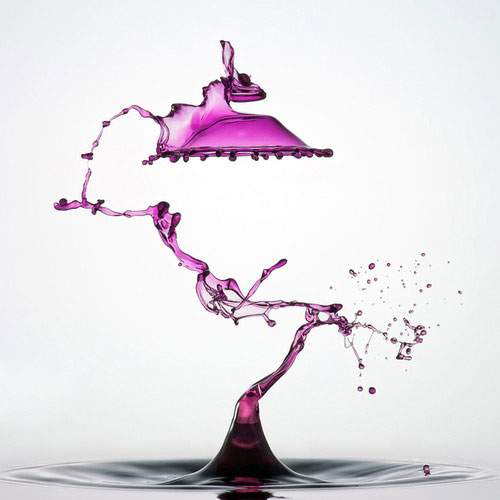 I’ve had students who've read the blog contact me, wanting to know how to learn more about the subject and how to pursue careers in fluid dynamics. It’s been very rewarding to pass my enthusiasm for the subject on to others. As a woman in a heavily male field, is gender ever an issue? Engineering in general and aerospace especially is quite male-dominated. The national average in aerospace is, I think, 10 to 15 percent female. I’ve been fortunate to be surrounded by professors, classmates and students who are supportive and professional. Any gender issues I’ve experienced have been minor. At the same time, though, it’s important to grow the female presence in the field, and establishing a sense of community helps, especially when women are faced day-in and day-out with being the only females in their class or lab. At Texas A&M, I teamed up with other women in our department to establish Aggie Aerospace Women in Engineering (AAWE), a homegrown organization dedicated to personal and professional networking and promoting aerospace engineering. We’ve held events with Boeing and SpaceX, had workshops on interviewing and salary negotiations (to help counteract gender wage gaps) and built up our membership. We even have quite a few male members. You're an avid cyclist and seem as passionate about racing as you do about your field of research. What drives you to compete and excel in the sport?
I’ve had students who've read the blog contact me, wanting to know how to learn more about the subject and how to pursue careers in fluid dynamics. It’s been very rewarding to pass my enthusiasm for the subject on to others. As a woman in a heavily male field, is gender ever an issue? Engineering in general and aerospace especially is quite male-dominated. The national average in aerospace is, I think, 10 to 15 percent female. I’ve been fortunate to be surrounded by professors, classmates and students who are supportive and professional. Any gender issues I’ve experienced have been minor. At the same time, though, it’s important to grow the female presence in the field, and establishing a sense of community helps, especially when women are faced day-in and day-out with being the only females in their class or lab. At Texas A&M, I teamed up with other women in our department to establish Aggie Aerospace Women in Engineering (AAWE), a homegrown organization dedicated to personal and professional networking and promoting aerospace engineering. We’ve held events with Boeing and SpaceX, had workshops on interviewing and salary negotiations (to help counteract gender wage gaps) and built up our membership. We even have quite a few male members. You're an avid cyclist and seem as passionate about racing as you do about your field of research. What drives you to compete and excel in the sport? 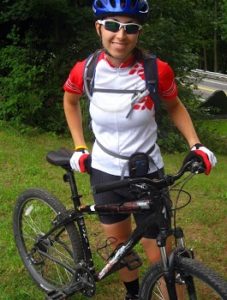 Riding is a source of stress relief for me, because on the bike I can’t think about anything else. Whether it's research difficulties, personal problems, or everyday stresses, all of them get erased while the pedals are turning. My mind focuses on the ride alone. I’m actually pretty new to cycling, having started riding less than three years ago. I joined A&M’s cycling team and started racing in Fall 2011, and now I compete in four very different disciplines of cycling: road racing, mountain biking, track cycling, and cyclocross. Do you have any other non-work/academic interests? I enjoy writing original fiction. I wrote a fantasy novel at 14 and haven’t stopped since. I also love going to Aggie women’s basketball games. My friend and I have had the same front row seats in the student section for years. I don’t get as many opportunities for hiking as I once did, but that’s another activity I love. What’s your plan of action after you finish your Ph.D.? My dream job is still astronaut, but, unfortunately, that’s not something NASA hires for very often. In the meantime, I’m trying to stay open to possibilities, whether in industry, academia, or a national laboratory. I’d like to keep up my educational outreach with FYFD or something similar. And, on a personal note, I’m looking forward to marrying my fiancé! Image: FYFD
Riding is a source of stress relief for me, because on the bike I can’t think about anything else. Whether it's research difficulties, personal problems, or everyday stresses, all of them get erased while the pedals are turning. My mind focuses on the ride alone. I’m actually pretty new to cycling, having started riding less than three years ago. I joined A&M’s cycling team and started racing in Fall 2011, and now I compete in four very different disciplines of cycling: road racing, mountain biking, track cycling, and cyclocross. Do you have any other non-work/academic interests? I enjoy writing original fiction. I wrote a fantasy novel at 14 and haven’t stopped since. I also love going to Aggie women’s basketball games. My friend and I have had the same front row seats in the student section for years. I don’t get as many opportunities for hiking as I once did, but that’s another activity I love. What’s your plan of action after you finish your Ph.D.? My dream job is still astronaut, but, unfortunately, that’s not something NASA hires for very often. In the meantime, I’m trying to stay open to possibilities, whether in industry, academia, or a national laboratory. I’d like to keep up my educational outreach with FYFD or something similar. And, on a personal note, I’m looking forward to marrying my fiancé! Image: FYFD
